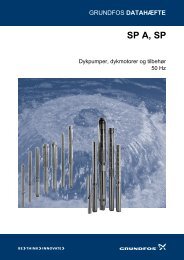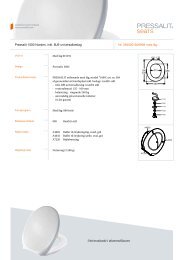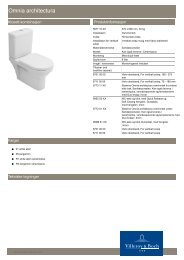Wilo-TOP-E / TOP-ED / TOP-EV - NRF
Wilo-TOP-E / TOP-ED / TOP-EV - NRF
Wilo-TOP-E / TOP-ED / TOP-EV - NRF
You also want an ePaper? Increase the reach of your titles
YUMPU automatically turns print PDFs into web optimized ePapers that Google loves.
– It is recommended that a shut-off device be installed<br />
in front of and behind the pump. This avoids the<br />
necessity to empty and fill the unit every time a<br />
pump has to be replaced.<br />
Additional isolating devices are no longer required<br />
for pump type <strong>TOP</strong>-<strong>EV</strong>. The isolating units are built<br />
into the pump casing. Therefore it is no longer<br />
necessary to drain and refill the installation as and<br />
when the motor module needs changing.<br />
Assembly is to be carried out in such a way that no<br />
drops fall onto the pump motor or the terminal box.<br />
– When assembling pumps with all-purpose flange<br />
PN 6/10 the following guidelines are to be observed<br />
(Fig. 10):<br />
1. It is not permitted to assemble all-purpose<br />
flanges with all-purpose flanges.<br />
2. enclosed plain washers (pos. 1) must be used<br />
between the screw/nut head and the all-purpose<br />
flange.<br />
ATTENTION! Safety elements (e.g. lock washers)<br />
are not permitted.<br />
ATTENTION! In the event of incorrect assembly<br />
the screw nut may become locked<br />
in the oblong hole. This may adversely<br />
influence the operatability<br />
of the flange connection due to the<br />
inadequate tension of the screws.<br />
3. It is recommended to use screws for flange<br />
connections of property class 4.6 if screws of<br />
higher properties are used for the assembly only<br />
the torque according to property class 4.6 is<br />
permissible.<br />
Permissible torque of property class 4.6:<br />
for M 12 f 40 Nm,<br />
for M 16 f 95 Nm<br />
ATTENTION! If screws of higher property classes<br />
are used, splintering may occur<br />
around the edges of the oblong<br />
holes due to the higher screw tensions.<br />
This will cause the screws to<br />
lose their tension and the flange<br />
connection may become leaky.<br />
4. Screws of sufficient length must be used:<br />
Flange connection<br />
PN 6<br />
Flange connection<br />
PN 10<br />
Thread<br />
M 12<br />
M 16<br />
min. screw length<br />
DN 40 DN 50/DN 65<br />
55 mm 60 mm<br />
60 mm<br />
65 mm<br />
ENGLISH<br />
– During the installation of <strong>TOP</strong>-<strong>EV</strong> union pumps, the<br />
valve unit must be hold with a spanner in the<br />
correct position while fixing the union nut.<br />
ATTENTION! The valve unit can turn during the<br />
assembly, the pump can be brought<br />
back in the correct position by<br />
turning. The hexagon for operating<br />
the valve should be positioned on<br />
the left side of the pump in order to<br />
garantee free access for the spanner.<br />
– When installing flow pipes in open units, the expansion<br />
flow pipe must branch off before the pump.<br />
– Assembly should be voltage-free. The pipes must<br />
be attached in such a way that the pump does not<br />
bear the weight of the pipes.<br />
– The direction of flow must correspond to the arrow<br />
on the pump housing.<br />
– The air inlet to the heat sink must not be blocked<br />
in any way.<br />
– Only installation positions in accordance with<br />
Fig. 8a/8b are permissible. The pump shaft must lie<br />
horizontally. For pumps with P1 ≥ 500 W the ribs of<br />
the heat sink must stand vertically to the electronic<br />
module. It is possible that the motor housing has to<br />
be turned after loosening the Allen screws.<br />
ATTENTION! In doing so, care must be taken not to<br />
damage the O-ring between the split<br />
pot and the pump housing. The O-ring<br />
must lie, unturned, in the edge of the<br />
split pot which faces the impeller.<br />
– Place both thermal lagging shells on the single pump<br />
and press them together so that the pilot pins lock<br />
into their respective, opposite holes.<br />
– ATTENTION! For units which are to be insulated,<br />
only the pump housing may be insulated.<br />
The condensation water<br />
holes on the motor flange must<br />
remain open.<br />
5.2 Electrical connection<br />
Electrical connection should be made by<br />
a qualified electrician. Current national<br />
regulations must be observed (e.g. VDE<br />
regulations in Germany).<br />
– According to Part 1 of the VDE 0730, the pump<br />
must be connected to the electrical supply by a<br />
solid wire (min. 3 x 1.5 mm2) equipped with a plug<br />
27







